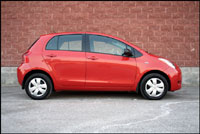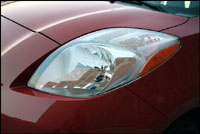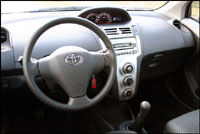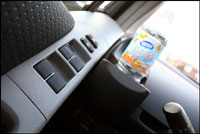In making the new car, Toyota took stretched its frame in
 |
| Profile is somewhat more rotund, but to the gain of the passengers inside. (Photo: Justin Couture, Canadian Auto Press) |
every dimensions, including a 110 mm (4.3 inch) growth in length, 90 mm (3.5 inches) of which ended up between the wheels, but the 30 mm (1.2 inch) growth in the vertical plane is the most obvious. To an interior designer of a subcompact car, this growth was most likely met with the same enthusiasm as one who'd just won the lotto; they've used every square millimeter of the interior volume with precision and care. Take the dashboard, for instance. Instead of it being a dashboard - no more, no less - they've added storage bins to what would otherwise be hollow space between it and the firewall. In fact, the Yaris has not one, but three gloveboxes, plus two pop-out cupholders, storage pockets on the sides of the centre console, and pockets with bottle-holders in the doors. Like I said, not a single area of this car was overlooked; they thought, designed, and then thought again; something that, in my opinion, other automakers should do more of.
The
 |
| Big, chunky lights consume much of the frontal profile. (Photo: Justin Couture, Canadian Auto Press) |
whole thing about maximization of space makes the Yaris a bit different than your regular, run of the mill automobile. One of the first things you notice, right as you plunk down into the seats is that the driving position is somehow different. The seats, which, by the way aren't height adjustable, give an unusually high vantage point out of the tall, glasshouse-like side windows and the panoramic windshield, which also contributes to the airy nature of the interior. There's also the notion that things are just a tad unique since there's no instrument bin in front of the steering wheel. Admittedly, it takes a bit of getting used to, but this position actually can help you feel at one with the car, and, for me at least, significantly boosted confidence when behind the wheel. It is so easy to tell exactly where the car's merge bumpers end, allowing me to fearlessly slot this tiny machine into every little nook and cranny.
Being the smallest and most affordable Toyota, I was expecting the
 |
| Yaris is quite different than most subcompact cars in its interior layout. (Photo: Justin Couture, Canadian Auto Press) |
Yaris to be about as plush as Russia's bleakest gulag, with no stereo, manual steering, and vinyl seats, more or less like the old, base Tercel, but I was pleasantly surprised. The seats are nice; with no distinctive side and squab bolsters to speak of, they look like one-piece Obus-form back supports trimmed in funky blue-fleck cloth. The headrests are made of extra-firm memory foam, trimmed in fuzzy black fabric. Other neat appointments include the centre stack, which, come to think of it, is one of the neatest visual components of the Yaris' cabin. The matte aluminum-look trim and vertical climate controls are surprisingly different, each of the oversized knobs featuring a heavy, well-weighted feel. The gearshift lever is unusually tall, putting it within easy reach of the driver; it's gait was decorated with a rubber 'accordion' boot, which got a couple of odd looks from passengers.
In
 |
| The differences in colours, textures and patterns keeps things bright on the inside. (Photo: Justin Couture, Canadian Auto Press) |
the outset of things, it should be noted that the plastics used here aren't soft-touch at all, this being made very apparent when you first rest your elbow on that unforgivingly hard arm rest on the door. Yet, in no way does the Yaris ever comes across as looking, or feeling cheap, thanks to an original angle on interior design and material use. Instead of giving these surfaces the typical leatherized grain, Toyota used an intriguing texture and a matte finish to reduce glare and sheen. A combination of different patterns, materials and colours give the car an upscale look without the negative upscale cost. The only downside that I can really think of is that the plastics used are relatively easy to scratch, and are difficult to keep clean.

